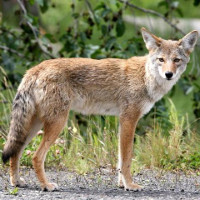 |
Coyote |
|
He is a wild animal |
Origin |
North America | |
Translation |
Francis Vandersteen |
| The possession of this animal is not authorized Royal Decree establishing the list of mammals not kept for production purposes that may be kept (M.B. 24.08.2009) |
| The Coyote is a species of canid in the genus Canis native to North America. It is smaller than its close relative, the gray wolf, and slightly smaller than the closely related eastern and red wolves. It occupies virtually the same ecological niche as the golden jackal in Eurasia, although it is larger and more predatory, and is therefore sometimes referred to by zoologists as the "American jackal". Males weigh between 8 and 20 kg on average, while females average between 7 and 18 kg, although their size varies according to geographic region. The northern subspecies, which averages 18 kg, tends to be larger than the southern Mexican subspecies, which averages 11.5 kg. It measures 58 to 66 cm in height at the withers. Body length varies on average from 1.0 to 1.35 m and tail length is 40 cm, with females being smaller in length and height. The largest coyote ever recorded was a male killed near Afton, Wyoming, on November 19, 1937, measuring 1.5 m from snout to tail and weighing 34 kg. The scent glands are located on the upper side of the base of the tail and are blue-black in color. The color and texture of the coyote's fur varies somewhat depending on location. The predominant coat color is light gray and red or fawn, interspersed around the body with black and white. High-altitude coyotes tend to have more black and gray shading than their desert counterparts, which are more tawny or whitish-gray. The fur consists of short, soft down and long, coarse jars. The fur of the northern subspecies is longer and denser than in the southern forms, while that of some Mexican and Central American subspecies is almost hispid (shaggy). In general, adult coyotes (including hybrid coyloups) have sand-colored coats, dark neonatal coats, bushy tails with active supracaudal glands and white facial masks. Albinism is extremely rare in coyotes; of a total of 750,000 coyotes harvested by federal and cooperative hunters between March 22, 1938 and June 30, 1945, only two were albino. The coyote is typically smaller than the gray wolf, but has longer ears and a relatively larger skull, as well as a slimmer build, mouth and muzzle. The scent glands are smaller than those of the gray wolf, but they are the same color6. Its coat color is much less varied than that of a wolf. The coyote also carries its tail downwards when running or walking, rather than horizontally like a wolf. The coyote is a very fast mammal, even when crippled, and can reach a maximum speed of 69 km/h in pursuit over a distance of around 300 meters. This makes it faster than the wolf, but with less stamina. It can also jump a distance of 4 meters. |






 English (United Kingdom)
English (United Kingdom)